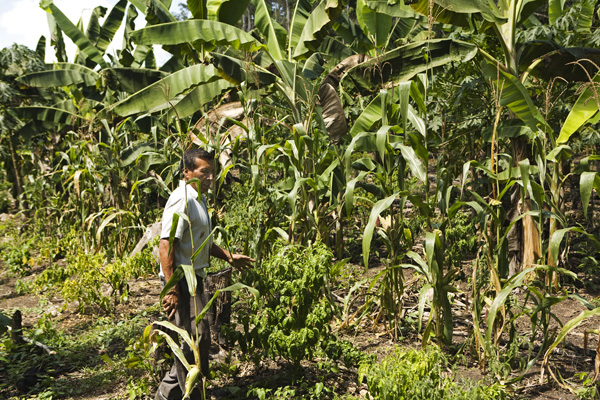
“Polyculture is agriculture using multiple crops in the same space, in imitation of the diversity of natural ecosystems, and avoiding large stands of single crops, or monoculture. It includes multi-cropping, intercropping, companion planting, beneficial weeds, and alley cropping.
Polyculture, though it often requires more labor [primarily when first planted], has several advantages over monoculture:
– The diversity of crops avoids the susceptibility of monocultures to disease. For example, a study in China reported in Nature showed that planting several varieties of rice in the same field increased yields by 89%, largely because of a dramatic (94%) decrease in the incidence of disease, which made pesticides redundant.
– The greater variety of crops provides habitat for more species, increasing local biodiversity. This is one example of reconciliation ecology, or accommodating biodiversity within human landscapes. It is also a function of a biological pest control program.
Polyculture is one of the principles of permaculture.”
“Agroforestry is an integrated approach of using the interactive benefits from combining trees and shrubs with crops and/or livestock. It combines agricultural and forestry technologies to create more diverse, productive, profitable, healthy, and sustainable land-use systems. A narrow definition of agroforestry is “trees on farms.”
There is some evidence that, especially in recent years, poor smallholder farmers are turning to agroforestry as a mean to adapt to the impacts of climate change. A study from the CGIAR research program on Climate Change, Agriculture and Food Security (CCAFS) found from a survey of over 700 households in East Africa that at least 50% of those households had begun planting trees on their farms in a change from their practices 10 years ago.[6] The trees ameliorate the effects of climate change by helping to stabilize erosion, improving water and soil quality and providing yields of fruit, tea, coffee, oil, fodder and medicinal products in addition to their usual harvest. Agroforestry was one of the most widely adopted adaptation strategies in the study, along with the use of improved crop varieties and intercropping.”
Image credit: Polyculture Design

I wonder how many of those farmers surveyed in East Africa in the CGIAR report quoted in this post were taught to plant trees, and/or supplied seeds by the Eden Foundation?
http://www.esthergarvi.org/
http://edengardens.org/
I don’t know that I would call what they are doing polyculturing, but it is indeed a massive step in that direction. At least there is not a growing trend of not cutting down their trees to keep birds from eating their millet crops (as they were taught by western colonial agriculture “experts” a few decades ago), and are planting trees instead.
The typing TYPO phantom strikes again. (That’s me.)
It should read “I don’t know that I would call”
and it also should read “At least there is now a growing trend”
Go ahead, make your jokes and have your fun at my expense everyone.
I deswerve it.
I mean I desurve it.
Uhhh. I deeserve it.
well… something like that anyway.
I reread old blog posts and comments from time to time and find typos I’ve made. I can easily edit them since it’s our blog. I like that because people probably think I never make mistakes (or maybe there are way more than I’m aware of — yikes).
Typoglycemia.
http://en.wikipedia.org/wiki/Typoglycemia
Taht is waht mkeas it pissolbe for mnay to raed waht I otefn type.
part of the reason we love the concept of the forest garden is because once established they are low maintenance. just want to let your readers know that they don’t need acres to start they can start small and slowly build it big.
Yes, that’s a big plus. Gardening takes a lot of time and effort, so we think it’s worth some extra work up front to reduce long term maintenance. Plus, we want to maximize the space we have.
The photo shows what we hope our forest garden will look like in a few years. Our garden is really growing fast. Things have grown 12”-18” since we did the videos about two weeks ago. http://www.youtube.com/user/naturalhomesteader We’ve had some nice steady rains since then. Give plants adequate rain, warm weather and plenty of nutrients and they’ll grow like crazy. Who would have known?
Follow the links and read about the various types of forest gardens. There are a lot of possibilities.
I think the reason forest gardens are so productive is because they closely mimic nature. Forest gardens are the total opposite of large scale industrial agriculture that’s ruining our food, soil and health.